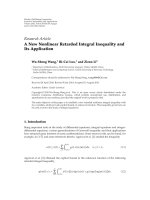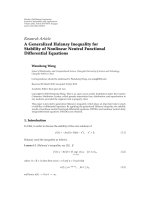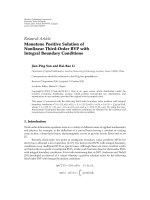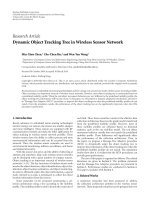Báo cáo hóa học: " Research Article Monotone Generalized Nonlinear Contractions in Partially Ordered Metric Spaces" docx
Bạn đang xem bản rút gọn của tài liệu. Xem và tải ngay bản đầy đủ của tài liệu tại đây (488.41 KB, 11 trang )
Hindawi Publishing Corporation
Fixed Point Theory and Applications
Volume 2008, Article ID 131294, 11 pages
doi:10.1155/2008/131294
Research Article
Monotone Generalized Nonlinear Contractions in
Partially Ordered Metric Spaces
Ljubomir
´
Ciri
´
c,
1
Nenad Caki
´
c,
2
Miloje Rajovi
´
c,
3
and Jeong Sheok Ume
4
1
Faculty of Mechanical Engineering, University of Belgrade, Kraljice Marije 16,
11 000 Belgrade, Serbia
2
Faculty of Electrical Engineering, University of Belgrade, Boulevard Kralja Aleksandra 73,
11 000 Belgrade, Serbia
3
Faculty of Mechanical Engineering, University of Kragujevac, Dositejeva 19,
36 000 Kraljevo, Serbia
4
Department of Applied Mathematics, Changwon National University,
Changwon 641-773, South Korea
Correspondence should be addressed to Ljubomir
´
Ciri
´
c,
Received 29 August 2008; Accepted 9 December 2008
Recommended by Juan Jose Nieto
A concept of g-monotone mapping is introduced, and some fixed and common fixed point
theorems for g-non-decreasing generalized nonlinear contractions in partially ordered complete
metric spaces are proved. Presented theorems are generalizations of very recent fixed point
theorems due to Agarwal et al. 2008.
Copyright q 2008 Ljubomir
´
Ciri
´
c et al. This is an open access article distributed under the Creative
Commons Attribution License, which permits unrestricted use, distribution, and reproduction in
any medium, provided the original work is properly cited.
1. Introduction
The Banach fixed point theorem for contraction mappings has been extended in many
directions cf. 1–28. Very recently Agarwal et al. 1 presented some new results for
generalized nonlinear contractions in partially ordered metric spaces. The main idea in
1, 20, 26 involve combining the ideas of iterative technique in the contraction mapping
principle with those in the monotone technique.
Recall that if X, ≤ is a partially ordered set and F : X → X is such that for x, y ∈
X, x ≤ y implies Fx ≤ Fy, then a mapping F is said to be non-decreasing. The main result
of Agarwal et al. in 1 is the following fixed point theorem.
Theorem 1.1 see 1, Theorem 2.2. Let X, ≤ be a partially ordered set and suppose there is a
metric d on X such that X, d is a complete metric space. Assume there is a non-decreasing function
ψ : 0, ∞ → 0, ∞ with lim
n →∞
ψ
n
t0 for each t>0 and also suppose F is a non-decreasing
2 Fixed Point Theory and Applications
mapping with
d
Fx,Fy
≤ ψ
max
dx, y,d
x, Fx
,d
y, Fy
,
1
2
d
x, Fy
d
y, Fx
1.1
for all x ≥ y. Also suppose either
a F is continuous or
b if {x
n
}⊂X is a non-decreasing sequence with x
n
→ x in X, then x
n
≤ x for all n hold.
If there exists an x
0
∈ X with x
0
≤ Fx
0
then F has a fixed point.
Agarwal et al. 1 observed that in certain circumstances it is possible to remove the
condition that ψ is non-decreasing in Theorem 1.1. So they proved the following fixed point
theorem.
Theorem 1.2 see 1, Theorem 2.3. Let X, ≤ be a partially ordered set and suppose there is a
metric d on X such that X, d is a complete metric space. Assume there is a continuous function
ψ : 0, ∞ → 0, ∞ with ψt <tfor each t>0 and also suppose F is a non-decreasing mapping
with
d
Fx,Fy ≤ ψ
max
dx, y,d
x, Fx
,d
y, Fy
∀x
≥ y. 1.2
Also suppose either (a) or (b) holds. If there exists an x
0
∈ X with x
0
≤ Fx
0
then F has a fixed point.
The problem to extend the result of Theorem 1.2 to mappings which satisfy 1.1
remained open. The aim of this note is to solve this problem by using more refined technique
of proofs. Moreover, we introduce a concept of g-monotone mapping and prove some fixed
and common fixed point theorems for g-non-decreasing generalized nonlinear contractions
in partially ordered complete metric spaces.
2. Main results
Definition 2.1. Suppose X, ≤ is a partially ordered set and F, g : X → X are mappings of X
into itself. One says F is g-non-decreasing if for x, y ∈ X,
gx ≤ gy implies Fx ≤ Fy. 2.1
Now we present the main result in this paper.
Theorem 2.2. Let X, ≤ be a partially ordered set and suppose there is a metric d on X such that
X, d is a complete metric space. Assume there is a continuous function ϕ: 0, ∞ → 0, ∞
Ljubomir
´
Ciri
´
cetal. 3
with ϕt <tfor each t>0 and also suppose F, g : X → X are such that FX ⊆ gX,Fis a
g-non-decreasing mapping and
d
Fx,Fy
≤ max
ϕ
d
gx,gy
,ϕ
d
gx,Fx
,ϕ
d
gy,Fy
,
ϕ
dgx,Fy d
gy,Fx
2
2.2
for all x, y ∈ X for which gx ≥ gy. Also suppose
if
g
x
n
⊂ X is a non-decreasing sequence with g
x
n
−→ gz in gX
then g
x
n
≤ gz,gz ≤ ggz
∀ n hold.
2.3
Also suppose gX is closed. If there exists an x
0
∈ X with gx
0
≤ Fx
0
, then F and g have a
coincidence. Further, if F, g commute at their coincidence points, then F and g have a common fixed
point.
Proof. Let x
0
∈ X be such that gx
0
≤ Fx
0
. Since FX ⊆ gX, we can choose x
1
∈ X so
that gx
1
Fx
0
. Again from FX ⊆ gX we can choose x
2
∈ X such that gx
2
Fx
1
.
Continuing this process we can choose a sequence {x
n
} in X such that
g
x
n1
F
x
n
∀n ≥ 0. 2.4
Since gx
0
≤ Fx
0
and Fx
0
gx
1
, we have gx
0
≤ gx
1
. Then from 2.1,
F
x
0
≤ F
x
1
. 2.5
Thus, by 2.4, gx
1
≤ gx
2
. Again from 2.1,
F
x
1
≤ F
x
2
, 2.6
that is, gx
2
≤ gx
3
. Continuing we obtain
F
x
0
≤ F
x
1
≤ F
x
2
≤ F
x
3
≤···≤F
x
n
≤ F
x
n1
≤··· . 2.7
In what follows we will suppose that dFx
n
,Fx
n1
> 0 for all n, since if Fx
n1
Fx
n
for some n, then by 2.4,
F
x
n1
g
x
n1
, 2.8
that is, F and g have a coincidence at x x
n1
, and so we have finished the proof. We will
show that
d
F
x
n
,F
x
n1
<d
F
x
n−1
,F
x
n
∀n ≥ 1. 2.9
4 Fixed Point Theory and Applications
From 2.4 and 2.7 we have that gx
n
≤ gx
n1
for all n ≥ 0. Then from 2.2 with
x x
n
and y x
n1
,
d
F
x
n
,F
x
n1
≤ max
ϕ
d
g
x
n
,g
x
n1
,ϕ
d
g
x
n
,F
x
n
,
ϕ
d
g
x
n1
,F
x
n1
,
ϕ
dgx
n
,Fx
n1
dgx
n1
,Fx
n
2
.
2.10
Thus by 2.4,
d
F
x
n
,F
x
n1
≤ max
ϕ
d
F
x
n−1
,F
x
n
,ϕ
d
F
x
n−1
,F
x
n
,
ϕ
d
F
x
n
,F
x
n1
,ϕ
1
2
d
Fx
n−1
,F
x
n1
.
2.11
Hence
d
F
x
n
,F
x
n1
≤ max
ϕ
d
F
x
n−1
,F
x
n
,ϕ
d
F
x
n
,F
x
n1
,
ϕ
1
2
d
F
x
n−1
,F
x
n1
.
2.12
If dFx
n
,Fx
n1
≤ ϕdFx
n−1
,Fx
n
, then 2.9 holds, as ϕt <tfor t>0.
Since we suppose that dFx
n
,Fx
n1
> 0andasϕt <tfor t>0, then
dFx
n
,Fx
n1
≤ ϕdFx
n
,Fx
n1
it is impossible.
If from 2.12 we have dFx
n
,Fx
n1
≤ ϕdFx
n−1
,Fx
n1
/2, and if
dFx
n−1
,Fx
n1
/2 > 0, then we have
d
F
x
n
,F
x
n1
≤ ϕ
1
2
d
F
x
n−1
,F
x
n1
<
1
2
d
F
x
n−1
,F
x
n1
≤
1
2
d
F
x
n−1
,F
x
n
1
2
d
F
x
n
,F
x
n1
.
2.13
Hence
d
F
x
n
,F
x
n1
<d
F
x
n−1
,F
x
n
. 2.14
Therefore, we proved that 2.9 holds.
Ljubomir
´
Ciri
´
cetal. 5
From 2.9 it follows that the sequence {dFx
n
,Fx
n1
} of real numbers is
monotone decreasing. Therefore, there is some δ ≥ 0 such that
lim
n →∞
d
F
x
n
,F
x
n1
δ. 2.15
Now we will prove that δ 0. By the triangle inequality,
1
2
d
F
x
n−1
,F
x
n1
≤
1
2
d
F
x
n−1
,F
x
n
d
F
x
n
,F
x
n1
. 2.16
Hence by 2.9,
1
2
d
F
x
n−1
,F
x
n1
<d
F
x
n−1
,F
x
n
. 2.17
Taking the upper limit as n →∞we get
lim sup
n →∞
1
2
d
F
x
n−1
,F
x
n1
≤ lim
n →∞
d
F
x
n−1
,F
x
n
. 2.18
If we set
lim sup
n →∞
1
2
d
F
x
n−1
,F
x
n1
b, 2.19
then clearly 0 ≤ b ≤ δ. Now, taking the upper limit on the both sides of 2.12 and have in
mind that ϕt is continuous, we get
lim
n →∞
d
F
x
n
,F
x
n1
≤ max
ϕ
lim
n →∞
d
F
x
n−1
,F
x
n
,ϕ
lim
n →∞
d
F
x
n
,F
x
n1
,
ϕ
lim sup
n →∞
1
2
d
F
x
n−1
,F
x
n1
.
2.20
Hence by 2.15 and 2.19,
δ ≤ max
ϕδ,ϕb
. 2.21
If we suppose that δ>0, then we have
δ ≤ max
ϕδ,ϕb
< max{δ, b} δ, 2.22
a contradiction. Thus δ 0. Therefore, we proved that
lim
n →∞
d
F
x
n
,F
x
n1
0. 2.23
6 Fixed Point Theory and Applications
Now we prove that {Fx
n
} is a Cauchy sequence. Suppose, to the contrary, that
{Fx
n
} is not a Cauchy sequence. Then there exist an >0 and two sequences of integers
{lk}, {mk},mk >lk ≥ k with
r
k
dFx
lk
,Fx
mk
≥ for k ∈{1, 2, }. 2.24
We may also assume
d
F
x
lk
,F
x
mk−1
< 2.25
by choosing mk to be the smallest number exceeding lk for which 2.24 holds. From
2.24, 2.25 and by the triangle inequality,
≤ r
k
≤ d
F
x
lk
,F
x
mk−1
d
F
x
mk−1
,F
x
mk
< d
F
x
mk−1
,F
x
mk
.
2.26
Hence by 2.23,
lim
k →∞
r
k
. 2.27
Since from 2.7 and 2.4 we have gx
lk1
Fx
lk
≤ Fx
mk
gx
mk1
, from
2.2 and 2.4 with x x
mk1
and y x
lk1
we get
d
F
x
lk1
,F
x
mk1
≤ max
ϕ
d
F
x
lk
,F
x
mk
,ϕ
d
F
x
lk
,F
x
lk1
,
ϕ
d
F
x
mk
,F
x
mk1
,
ϕ
dFx
lk
,Fx
mk1
dFx
mk
,Fx
lk1
2
.
2.28
Denote δ
n
dFx
n
,Fx
n1
. Then we have
d
F
x
lk1
,F
x
mk1
≤ max
ϕ
r
k
,ϕ
δ
lk
,ϕ
δ
mk
,
ϕ
dFx
lk
,Fx
mk1
dFx
mk
,Fx
lk1
2
.
2.29
Therefore, since
r
k
≤ d
F
x
lk
,F
x
lk1
d
F
x
lk1
,F
x
mk1
d
F
x
mk
,F
x
mk1
δ
lk
δ
mk
d
F
x
lk1
,F
x
mk1
,
2.30
Ljubomir
´
Ciri
´
cetal. 7
we have
≤ r
k
≤ δ
lk
δ
mk
max
ϕr
k
,ϕ
δ
lk
,ϕ
δ
mk
,ϕ
dFx
lk
,Fx
mk1
dFx
mk
,Fx
lk1
2
.
2.31
By the triangle inequality, 2.24 and 2.25,
≤ r
k
≤ d
F
x
lk
,F
x
mk1
δ
mk
,
d
F
x
lk
,F
x
mk1
≤ d
F
x
lk
,F
x
mk−1
δ
mk−1
δ
mk
≤ δ
mk−1
δ
mk
.
2.32
From 2.32,
− δ
mk
≤ d
F
x
lk
,F
x
mk1
≤ δ
mk−1
δ
mk
. 2.33
Similarly,
≤ r
k
≤ δ
lk
d
F
x
lk1
,F
x
mk
,
d
F
x
lk1
,F
x
mk
≤ δ
lk
d
Fx
lk
,F
x
mk−1
δ
mk−1
≤ δ
mk−1
δ
mk
.
2.34
Hence
− δ
lk
≤ d
F
x
mk
,F
x
lk1
≤ δ
mk−1
δ
lk
. 2.35
From 2.33 and 2.35,
−
δ
lk
δ
mk
2
≤
dFx
lk
,Fx
mk1
dFx
mk
,Fx
lk1
2
≤ δ
mk−1
δ
lk
δ
mk
2
.
2.36
Thus from 2.36 and 2.23 we get
lim
k →∞
dFx
lk
,Fx
mk1
dFx
mk
,Fx
lk1
2
. 2.37
Letting n →∞in 2.31, then by 2.23, 2.27 and 2.37 we get, as ϕ is continuous,
≤ max
ϕ, 0, 0,ϕ
<, 2.38
8 Fixed Point Theory and Applications
a contradiction. Thus our assumption 2.24 is wrong. Therefore, {Fx
n
} is a Cauchy
sequence. Since by 2.4 we have {Fx
n
} {gx
n1
}⊆gX and gX is closed, there exists
z ∈ X such that
lim
n →∞
g
x
n
gz. 2.39
Now we show that z is a coincidence point of F and g. Since from 2.3 and 2.39 we
have gx
n
≤ gz for all n, then by the triangle inequality and 2.2 we get
d
gz,Fz
≤ d
gz,F
x
n
d
F
x
n
,Fz
≤ d
gz,F
x
n
max
ϕ
d
g
x
n
,gz
,ϕ
d
g
x
n
,F
x
n
,
ϕ
d
gz,Fz
,ϕ
dgx
n
,Fz dgz,Fx
n
2
.
2.40
So letting n →∞yields dgz,Fz ≤ max{ϕdgz,Fz,ϕdgz,Fz/2}. Hence
dgz,Fz 0, hence Fzgz. Thus we proved that F and g have a coincidence.
Suppose now that F and g commute at z.Setw gzFz. Then
Fw
F
gz
g
Fz
gw. 2.41
Since from 2.3 we have gz ≤ ggz gw and as gzFz and gwFw, from
2.2 we get
d
Fz,Fw
≤ max
ϕ
d
gz,gw
,ϕ
d
g
z,Fz
,
ϕ
d
gw,Fw
,ϕ
dgz,Fw dgw,Fz
2
ϕ
d
Fz,Fw
.
2.42
Hence dFz,Fw 0, that is, dw, Fw 0. Therefore,
Fwgww. 2.43
Thus we proved that F and g have a common fixed point.
Remark 2.3. Note F is g-non-decreasing can be replaced by F is g-non-increasing in
Theorem 2.2 provided gx
0
≤ Fx
0
is replaced by Fx
0
≥ gx
0
in Theorem 2.2.
Ljubomir
´
Ciri
´
cetal. 9
Corollary 2.4. Let X, ≤ be a partially ordered set and suppose there is a metric d on X such that
X, d is a complete metric space. Assume there is a continuous function ϕ : 0, ∞ → 0, ∞
with ϕt <tfor each t>0 and also suppose F : X → X is a non-decreasing mapping and
d
Fx,Fy
≤ max
ϕ
dx, y
,ϕ
d
x, Fx
,ϕ
d
y, Fy
,
ϕ
dx, Fy d
y, Fx
2
2.44
for all x, y ∈ X for which x ≤ y. Also suppose either
i if {x
n
}⊂X is a non-decreasing sequence with x
n
→ z in X then x
n
≤ z for all n hold or
ii F is continuous.
If there exists an x
0
∈ X with x
0
≤ Fx
0
then F has a fixed point.
Proof. If i holds, then taking g I I the identity mapping in Theorem 2.2 we obtain
Corollary 2.4.Ifii holds, then from 2.39 with g I we get
z lim
n →∞
x
n1
lim
n →∞
Fx
n
F
lim
n →∞
x
n
Fz. 2.45
Corollary 2.5. Let X, ≤ be a partially ordered set and suppose there is a metric d on X such that
X, d is a complete metric space. Assume there is a continuous function ϕ : 0, ∞ → 0, ∞
with ϕt <tfor each t>0 and also suppose F : X → X is a non-decreasing mapping and
d
Fx,Fy
≤ max
ϕ
dx, y
,ϕ
dx, Fx
,ϕ
d
y, Fy
2.46
for all x, y ∈ X for which x ≤ y. Also suppose either
i if
{x
n
}⊂X is a non-decreasing sequence with x
n
→ z in X then x
n
≤ z for all n hold or
ii F is continuous.
If there exists an x
0
∈ X with x
0
≤ Fx
0
then F has a fixed point.
Remark 2.6. Since 1.2 implies 2.46 with ψ ϕ, Corollary 2.5 is a generalization of
Theorem 1.2. If in addition ψ and ϕ are non-decreasing, then Theorem 1.2 and Corollary 2.5
are equivalent.
Taking ϕtkt, 0 <k<1, in Corollary 2.4 we obtain the following generalization of
the results in 20, 26.
Corollary 2.7. Let X, ≤ be a partially ordered set and suppose there is a metric d on X such that
X, d is a complete metric space. Suppose F : X → X is a non-decreasing mapping and
d
Fx,Fy
≤ k max
dx, y,d
x, Fx
,d
y, Fy
,
dx, Fy dy, Fx
2
2.47
10 Fixed Point Theory and Applications
for all x, y ∈ X for which x ≤ y, where 0 <k<1. Also suppose either
i if {x
n
}⊂X is a non-decreasing sequence with x
n
→ z in X then x
n
≤ z for all n hold or
ii F is continuous.
If there exists an x
0
∈ X with x
0
≤ Fx
0
then F has a fixed point.
Acknowledgments
This research is financially supported by Changwon National University in 2008. The first,
second, and third authors thank the Ministry of Science and Technology of Serbia for their
support.
References
1 R. P. Agarwal, M. A. El-Gebeily, and D. O’Regan, “Generalized contractions in partially ordered
metric spaces,” Applicable Analysis, vol. 87, no. 1, pp. 109–116, 2008.
2 R. P. Agarwal, D. O’Regan, and M. Sambandham, “Random and deterministic fixed point theory for
generalized contractive maps,” Applicable Analysis, vol. 83, no. 7, pp. 711–725, 2004.
3 B. Ahmad and J. J. Nieto, “The monotone iterative technique for three-point second-order
integrodifferential boundary value problems with p-Laplacian,” Boundary Value Problems, vol. 2007,
Article ID 57481, 9 pages, 2007.
4 D. W. Boyd and J. S. W. Wong, “On nonlinear contractions,” Proceedings of the American Mathematical
Society, vol. 20, no. 2, pp. 458–464, 1969.
5 A. Cabada and J. J. Nieto, “Fixed points and approximate solutions for nonlinear operator equations,”
Journal of Computational and Applied Mathematics, vol. 113, no. 1-2, pp. 17–25, 2000.
6 Lj.
´
Ciri
´
c, “Generalized contractions and fixed-point theorems,” Institut Math
´
ematique. Publications, vol.
12, no. 26, pp. 19–26, 1971.
7 Lj.
´
Ciri
´
c, “A generalization of Banach’s contraction principle,” Proceedings of the American Mathematical
Society, vol. 45, no. 2, pp. 267–273, 1974.
8 Lj.
´
Ciri
´
c, “Fixed points of weakly contraction mappings,” Institut Math
´
ematique. Publications, vol. 20,
no. 34, pp. 79–84, 1976.
9 Lj.
´
Ciri
´
c, “Coincidence and fixed points for maps on topological spaces,” Topology and Its Applications,
vol. 154, no. 17, pp. 3100–3106, 2007.
10 Lj.
´
Ciri
´
c and J. S. Ume, “Nonlinear quasi-contractions on metric spaces,” Praktik
`
at
ˆ
es Akadem
´
ıas
Ath
¨
enon, vol. 76, part A, pp. 132–141, 2001.
11 Lj.
´
Ciri
´
c, “Common fixed points of nonlinear contractions,” Acta Mathematica Hungarica, vol. 80, no.
1-2, pp. 31–38, 1998.
12 Z. Drici, F. A. McRae, and J. Vasundhara Devi, “Fixed-point theorems in partially ordered metric
spaces for operators with PPF dependence,” Nonlinear Analysis: Theory, Methods & Applications, vol.
67, no. 2, pp. 641–647, 2007.
13 T. G. Bhaskar and V. Lakshmikantham, “Fixed point theorems in partially ordered metric spaces and
applications,” Nonlinear Analysis: Theory, Methods & Applications, vol. 65, no. 7, pp. 1379–1393, 2006.
14 L. Gaji
´
candV.Rako
ˇ
cevi
´
c, “Quasicontraction nonself-mappings on convex metric spaces and common
fixed point theorems,” Fixed Point Theory and Applications, vol. 2005, no. 3, pp. 365–375, 2005.
15 N. Hussain, “Common fixed points in best approximation for Banach operator pairs with
´
Ciri
´
ctype
I-contractions,” Journal of Mathematical Analysis and Applications, vol. 338, no. 2, pp. 1351–1363, 2008.
16 G. S. Ladde, V. Lakshmikantham, and A. S. Vatsala, Monotone Iterative Techniques for Nonlinear
Differential Equations, Monographs, Advanced Texts and Surveys in Pure and Applied Mathematics,
27, Pitman, Boston, Mass, USA, 1985.
17 V. Lakshmikantham and Lj.
´
Ciri
´
c, “Coupled fixed point theorems for nonlinear contractions in
partially ordered metric spaces,” Nonlinear Analysis: Theory, Methods & Applications. In press.
18 Z. Q. Liu, Z. N. Guo, S. M. Kang, and S. K. Lee, “On
´
Ciri
´
c type mappings with nonunique fixed and
periodic points,” International Journal of Pure and Applied Mathematics, vol. 26, no. 3, pp. 399–408, 2006.
Ljubomir
´
Ciri
´
cetal. 11
19 J. J. Nieto, “An abstract monotone iterative technique,” Nonlinear Analysis: Theory, Methods &
Applications, vol. 28, no. 12, pp. 1923–1933, 1997.
20 J. J. Nieto and R. Rodr
´
ıguez-L
´
opez, “Contractive mapping theorems in partially ordered sets and
applications to ordinary differential equations,” Order, vol. 22, no. 3, pp. 223–239, 2005.
21 J. J. Nieto and R. Rodr
´
ıguez-L
´
opez, “Monotone method for first-order functional differential
equations,” Computers & Mathematics with Applications, vol. 52, no. 3-4, pp. 471–484, 2006.
22 J. J. Nieto and R. Rodr
´
ıguez-L
´
opez, “Existence and uniqueness of fixed point in partially ordered
sets and applications to ordinary differential equations,” Acta Mathematica Sinica, vol. 23, no. 12, pp.
2205–2212, 2007.
23 J. J. Nieto, R. L. Pouso, and R. Rodr
´
ıguez-L
´
opez, “Fixed point theorems in ordered abstract spaces,”
Proceedings of the American Mathematical Society, vol. 135, no. 8, pp. 2505–2517, 2007.
24 H. K. Pathak, Y. J. Cho, and S. M. Kang, “An application of fixed point theorems in best approximation
theory,” International Journal of Mathematics and Mathematical Sciences, vol. 21, no. 3, pp. 467–470, 1998.
25 P. Raja and S. M. Vaezpour, “Some extensions of Banach’s contraction principle in complete cone
metric spaces,” Fixed Point Theory and Applications, vol. 2008, Article ID 768294, 11 pages, 2008.
26 A. C. M. Ran and M. C. B. Reurings, “A fixed point theorem in partially ordered sets and some
applications to matrix equations,” Proceedings of the American Mathematical Society, vol. 132, no. 5, pp.
1435–1443, 2004.
27 B. K. Ray, “On
´
Ciri
´
c’s fixed point theorem,” Polska Akademia Nauk. Fundamenta Mathematicae, vol. 94,
no. 3, pp. 221–229, 1977.
28 D. O’Regan and A. Petrus¸el, “Fixed point theorems for generalized contractions in ordered metric
spaces,” Journal of Mathematical Analysis and Applications
, vol. 341, no. 2, pp. 1241–1252, 2008.









